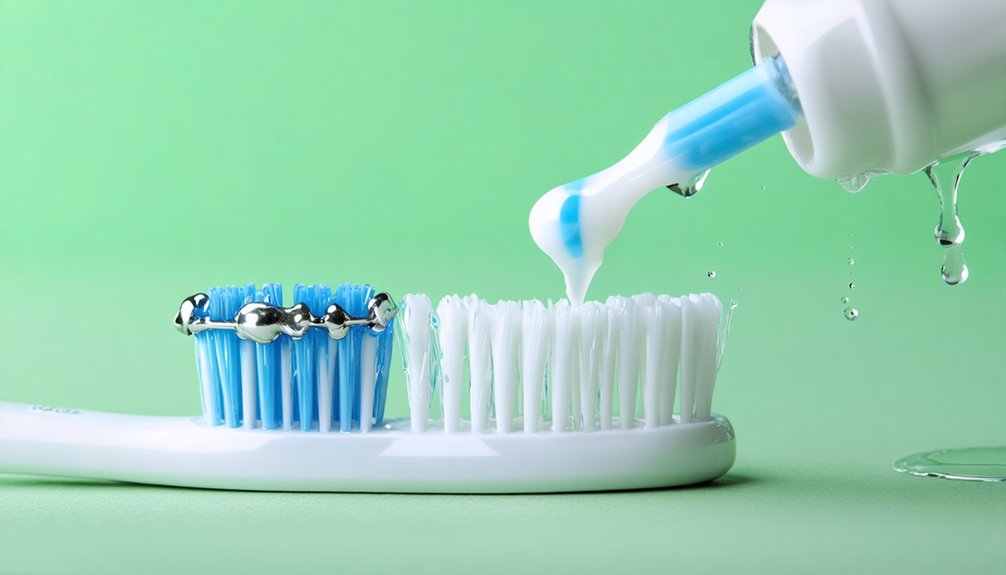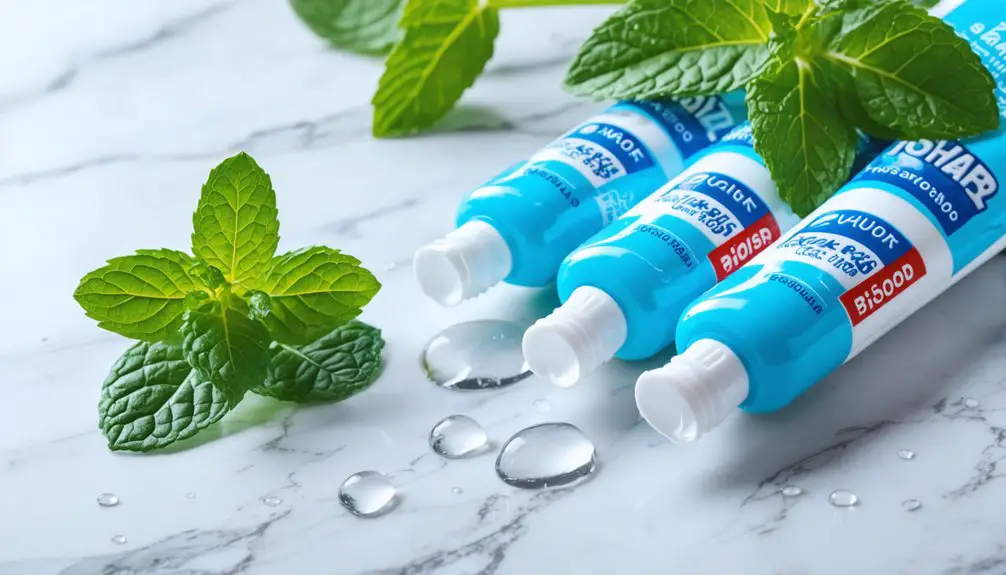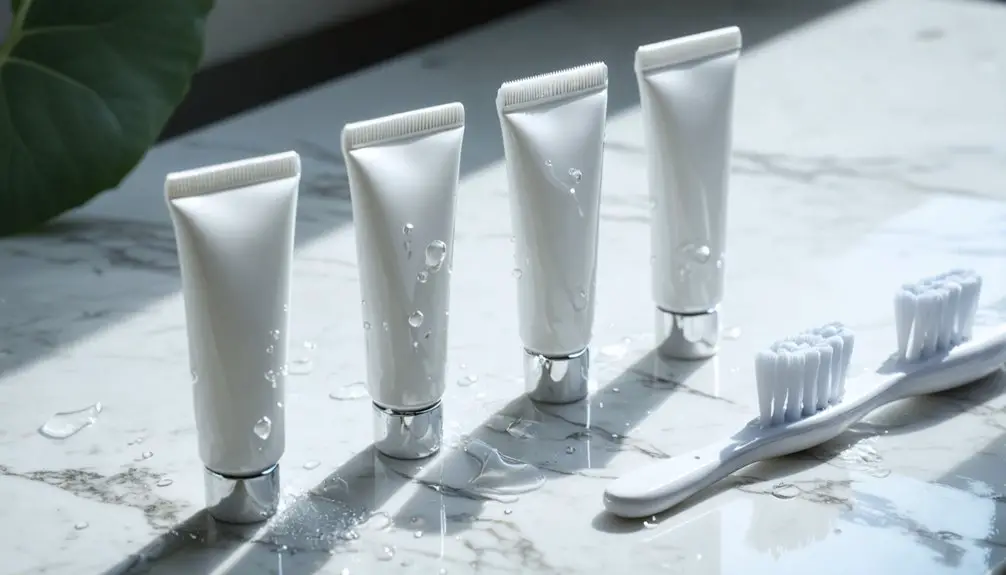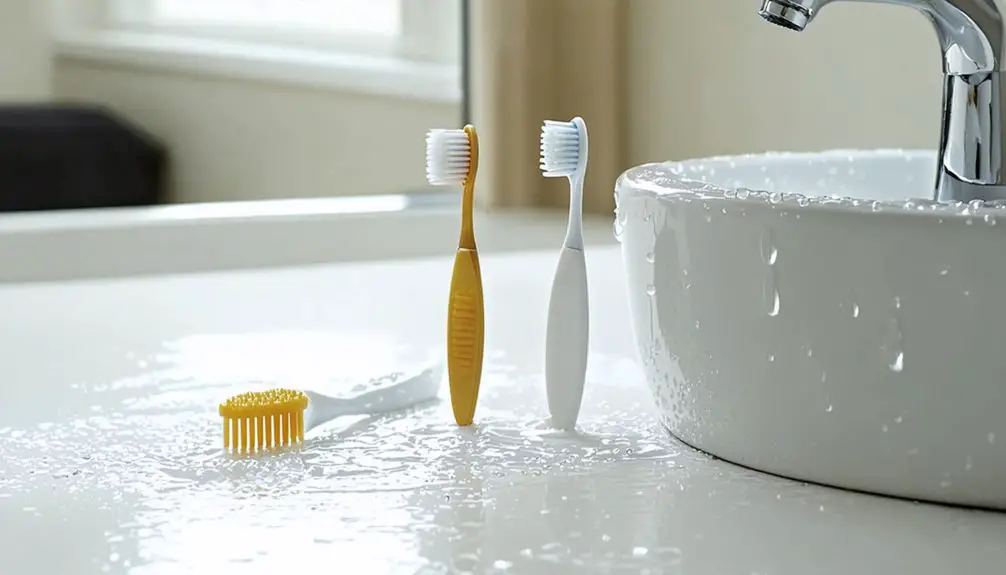When wearing braces, you’ll need specialized toothpaste with non-abrasive formulas and ideal fluoride levels (1,000-1,500 ppm) to protect your orthodontic investment. Choose products specifically designed for braces that contain gentle polishing agents and anti-plaque properties to combat debris trapped around brackets and wires. Avoid whitening agents during treatment, and opt for brands like Colgate Total or Crest Pro-Health. Understanding the right ingredients and techniques will help guarantee your brightest, healthiest smile throughout your orthodontic journey.
Key Takeaways
- Choose toothpaste with 1,000-1,500 ppm fluoride content to strengthen enamel and protect against cavities while wearing braces.
- Use non-abrasive formulas containing natural silica to safely clean around brackets without damaging orthodontic appliances.
- Avoid whitening toothpaste during treatment to prevent uneven tooth coloration when braces are removed.
- Select specialized braces-friendly toothpaste like Colgate Total or Crest Pro-Health for optimal plaque control around brackets.
- Brush gently in circular motions at 45-degree angles for two minutes twice daily to maintain bright, healthy teeth.
Why Special Toothpaste Matters for Braces
While regular toothpaste might suffice for those without orthodontic appliances, wearing braces creates unique oral hygiene challenges that require specialized toothpaste formulations.
Orthodontic braces demand specialized dental care beyond standard toothpaste to address the unique challenges of maintaining proper oral hygiene.
The brackets and wires of your braces form numerous tiny spaces where food particles and plaque can accumulate, making proper braces maintenance essential.
You’ll need toothpaste specifically designed for enhanced plaque control, as traditional formulas may not effectively reach these challenging areas.
Without proper care, you risk developing cavities, white spot lesions, and gum inflammation.
Special toothpaste formulations contain targeted ingredients that help prevent these complications by breaking down stubborn buildup and protecting your enamel.
They’re particularly effective at reaching around brackets and under wires, ensuring thorough cleaning while maintaining the integrity of your orthodontic hardware.
Fluoride content between 1,000 to 1,500 ppm provides optimal protection against decay during treatment.
Using toothpaste with gentle abrasives helps remove debris while protecting your enamel from excessive wear during orthodontic treatment.
Essential Ingredients to Look for in Braces-Friendly Toothpaste
When choosing toothpaste for your braces, fluoride content should be your primary consideration as it strengthens enamel and helps prevent cavities around brackets where plaque tends to accumulate.
You’ll want a toothpaste with the ADA seal to guarantee ideal fluoride levels that protect against demineralization while creating an effective barrier against acid attacks.
To protect both your teeth and orthodontic hardware, select a non-abrasive formula that won’t damage brackets or wear down enamel while still maintaining effective cleaning power. Look for products containing calcium phosphates to promote overall tooth strength and resilience during orthodontic treatment. Special toothpaste formulas with anti-plaque properties are beneficial since food and debris can easily get trapped in brackets and wires.
Fluoride Content Matters Most
Because fluoride serves as the cornerstone of oral health during orthodontic treatment, it’s crucial to choose a toothpaste with ideal fluoride content for braces.
You’ll want to select products containing 1,000 to 1,500 parts per million (ppm) of fluoride sources for standard protection, though your orthodontist may recommend higher concentrations up to 5,000 ppm for enhanced enamel protection.
Fluoride actively strengthens your teeth by attracting calcium and phosphate ions, creating a protective shield against cavities and white spot lesions common in braces wearers.
It’s particularly effective when combined with nano-hydroxyapatite and vitamins D3 and K2, which boost mineralization.
This mineral also helps neutralize acids and inhibit bacterial growth around brackets and wires, making it your primary defense against decay during orthodontic treatment.
The addition of xylitol enrichment helps maintain optimal moisture levels in your mouth while wearing braces.
Using a non-abrasive toothpaste formula helps protect both your braces and tooth enamel while maintaining optimal cleaning effectiveness.
Non-Abrasive Formula Benefits
Three key characteristics define an ideal non-abrasive toothpaste formula for braces wearers: gentle polishing agents, soothing compounds, and protective ingredients.
When choosing your toothpaste, look for natural silica as your primary gentle cleaning agent. It effectively removes plaque and surface stains without damaging your brackets or wires. Professional cleaning will still be needed to remove any hardened tartar buildup.
For enamel protection, calcium phosphates help strengthen teeth around brackets, while xylitol inhibits harmful bacteria. Daily brushing with appropriate toothpaste helps prevent white spots around brackets that indicate decay.
You’ll want soothing ingredients like aloe, chamomile, and olive leaf extract to combat gum inflammation from bracket friction. These natural compounds work alongside antimicrobial agents such as coconut oil and zinc citrate to maintain healthy gums.
Avoid toothpastes containing harsh additives like SLS, artificial colors, or excessive detergents, as these can irritate sensitive tissues and compromise your orthodontic treatment’s success.
Top-Rated Toothpaste Options for Orthodontic Care
When selecting toothpaste for your braces, you’ll want to focus on products that combine essential protective ingredients like fluoride and calcium phosphates with non-abrasive cleaning power.
Leading options like Crest Pro-Health HD and Sensodyne Pronamel Gentle Whitening offer specialized formulations that effectively clean around brackets while preventing enamel damage. Always check for the ADA seal of approval to ensure your toothpaste meets rigorous dental care standards.
You’ll maximize benefits by choosing toothpaste that aligns with your specific needs, whether that’s sensitivity relief, natural ingredients, or enhanced gum protection found in brands like Colgate Total and Tom’s of Maine.
Understanding Toothpaste Selection Criteria
Selecting the right toothpaste while wearing braces requires careful consideration of several critical factors that directly impact oral health during orthodontic treatment.
You’ll want to focus on fluoride content between 1,000-1,500 ppm to protect your enamel and prevent decay around brackets. Choose non-whitening, low-abrasive formulas to maintain even tooth coloring and avoid damaging your enamel.
If you’re experiencing sensitivity, opt for specialized formulations like Sensodyne Pronamel that soothe discomfort while protecting your teeth. Rick Burns Orthodontics provides expert recommendations for sensitivity-specific toothpaste options.
Look for toothpaste types specifically designed for braces, as they’re formulated to clean effectively around orthodontic hardware and prevent white spot lesions.
For ideal oral hygiene, select products with the Seal of Acceptance, ensuring they meet rigorous safety and effectiveness standards.
Active Ingredients That Matter
The active ingredients in toothpaste for braces wearers play a specific role in maintaining oral health during orthodontic treatment.
You’ll find sodium fluoride at 1,450 ppm as a primary ingredient, providing essential enamel protection and remineralization around brackets. For enhanced protection, prescription-strength options containing up to 5,000 ppm fluoride offer superior defense against white spot lesions.
The antimicrobial effectiveness of cetylpyridinium chloride (0.05%) helps combat bacterial plaque buildup, while xylitol delivers dual active ingredient benefits as both an antimicrobial agent and sweetener.
Silica serves as a gentle abrasive for thorough cleaning without damaging orthodontic appliances.
When selecting your toothpaste, avoid whitening agents during treatment, as they can lead to uneven coloration once your braces are removed.
Maximizing Braces-Safe Benefits
Since maintaining ideal oral hygiene with braces requires specialized care, choosing the right toothpaste can greatly impact your orthodontic treatment’s success.
Focus on products specifically formulated for braces care, like Colgate Total or Crest Pro-Health, which deliver extensive protection against cavities and plaque while being gentle on brackets and wires.
For best results, select toothpaste with fluoride concentrations between 1,000-1,500 ppm to strengthen your enamel during treatment.
If you’re experiencing sensitivity after adjustments, consider Sensodyne Pronamel, which offers protective benefits without harsh abrasives.
For those preferring natural options, Tom’s of Maine Natural Antiplaque provides effective oral hygiene while avoiding synthetic additives.
Remember to pair your chosen toothpaste with proper brushing technique to maximize its braces-safe benefits.
The Power of Fluoride in Protecting Braced Teeth
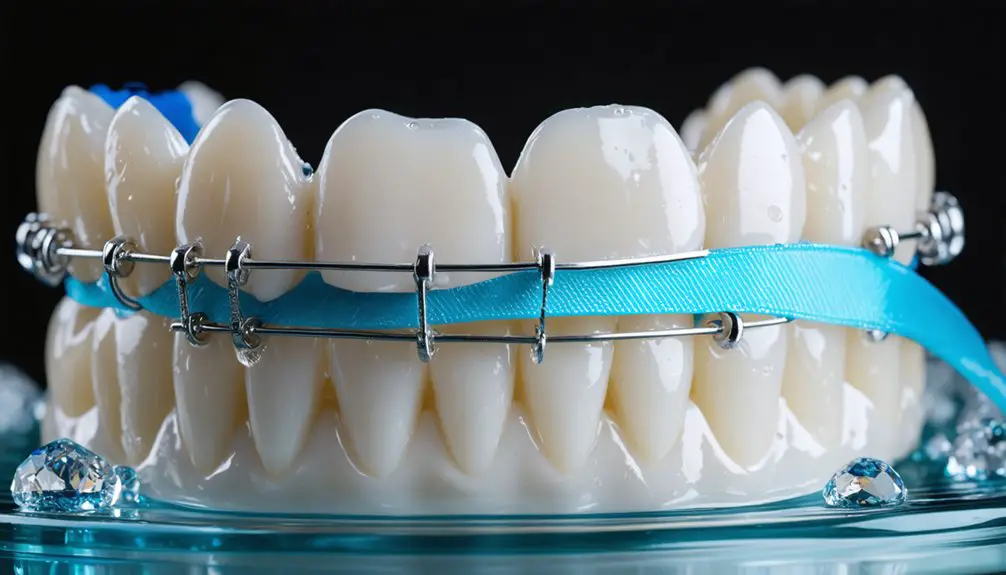
While wearing braces increases your risk of tooth decay, fluoride serves as a powerful protective shield for your teeth during orthodontic treatment. Through fluoride absorption, your enamel becomes more resistant to acid attacks from plaque and bacteria that commonly accumulate around brackets and wires.
Regular fluoride exposure greatly reduces cavity formation by up to 40%, even when your oral hygiene isn’t perfect.
You’ll find fluoride’s greatest strength in promoting enamel remineralization, especially in treating white spot lesions – those chalky marks that can develop during orthodontic care.
For maximum protection, combine daily fluoride toothpaste with professional treatments like high-concentration gels or foams. Your orthodontist may recommend prescription-strength fluoride products to provide enhanced defense, particularly if you’re at higher risk for decay or struggling with thorough cleaning around your braces.
How to Choose the Right Toothpaste for Your Braces
Choosing appropriate toothpaste when wearing braces can considerably impact your orthodontic treatment’s success.
Selecting the right toothpaste during orthodontic treatment is crucial for protecting your investment and ensuring optimal results with braces.
When selecting your toothpaste for braces maintenance, look for formulations containing fluoride (1000-1500 ppm) and non-abrasive ingredients that won’t damage your brackets or wires.
You’ll want to select products specifically designed for sensitivity protection, as braces often cause temporary tooth discomfort. Trusted options include Colgate Total, Crest Pro-Health, or Sensodyne Pronamel.
While toothpaste flavors matter for comfort, prioritize products with anti-plaque and tartar control properties to combat buildup around brackets.
Avoid harsh whitening agents or highly abrasive formulas that could compromise your orthodontic hardware.
If you prefer natural options, make sure they contain sufficient fluoride for cavity protection during your treatment period.
Daily Oral Care Tips to Maximize Your Toothpaste’s Effectiveness
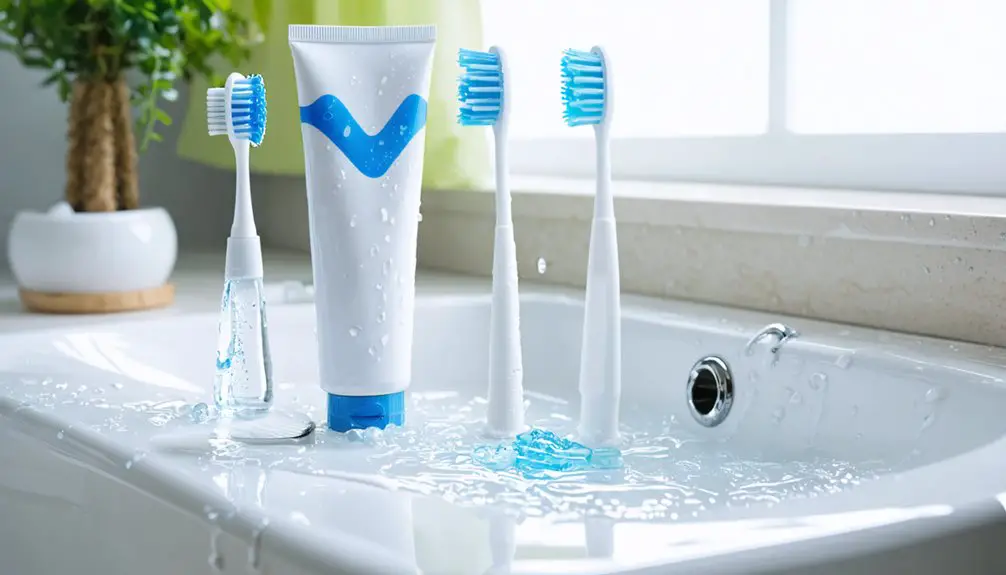
To maximize your toothpaste’s effectiveness with braces, maintaining proper daily oral care techniques is essential. Apply gentle circular toothbrush techniques at a 45-degree angle, brushing for at least two minutes twice daily. You’ll need to clean above, below, and around your brackets thoroughly using a soft-bristled or orthodontic toothbrush.
After brushing, incorporate an antibacterial mouthwash to enhance your oral care routine. The mouthwash benefits include targeting bacteria trapped in braces and reducing inflammation.
Don’t forget to floss daily using orthodontic floss or water flossers to remove debris between teeth. Avoid whitening toothpaste, as it can cause uneven coloration. Instead, use fluoride toothpaste to strengthen your enamel and protect against cavities during your orthodontic treatment.
Frequently Asked Questions
How Long Should I Wait After Getting Braces Before Brushing With Toothpaste?
You shouldn’t wait at all – start brushing techniques and dental hygiene the same day you get braces. Use fluoride toothpaste right away, brushing gently after every meal for 2-3 minutes.
Can I Use Charcoal Toothpaste With My Braces?
Purposely pass on charcoal toothpaste with your braces. Despite charcoal benefits, braces safety comes first. You’ll risk trapped particles, enamel damage, and staining. Choose fluoride-based toothpaste instead.
Should I Brush Differently When Using Orthodontic-Specific Toothpaste?
You’ll use the same brushing techniques with orthodontic-specific toothpaste – angle at 45 degrees, make circular motions, and clean thoroughly around brackets. The key difference is the specialized formula for orthodontic care.
How Often Should I Replace My Toothpaste While Wearing Braces?
Time and tide wait for no one, and neither should your toothpaste. You’ll need to replace it every 3-4 weeks with braces, since you’re brushing more frequently for proper oral hygiene.
Will Using Braces-Specific Toothpaste Help Prevent Metal Taste in My Mouth?
Yes, braces-specific toothpaste can help reduce metal taste by controlling bacteria and plaque buildup around brackets. Your consistent braces hygiene routine with specialized toothpaste will minimize metallic sensations considerably.
References
- https://thedentalcareblog.com/cosmetic/choosing-the-right-toothpaste-for-braces-what-you-need-to-know/
- https://smilezonedental.net/best-toothpaste-for-braces/
- https://bergenortho.com/top-toothpaste-choices-for-braces-wearers/
- https://tisserontorthodontics.com/toothpaste-for-braces/
- https://kumraortho.com/blog/best-toothpaste-for-braces/
- https://www.rickburnsortho.com/which-toothpaste-is-best-for-dental-braces-tips-from-an-orthodontist/
- https://halabiorthodontics.com/best-toothpaste-for-braces/
- https://supermouth.com/products/supermouth-hydroxamin-with-fluoride-ortho-toothpaste-3-4-oz
- https://pmc.ncbi.nlm.nih.gov/articles/PMC6863098/
- https://madebyradius.com/blogs/good-to-know/braces-friendly-natural-oral-care-what-ingredients-to-avoid-seek
